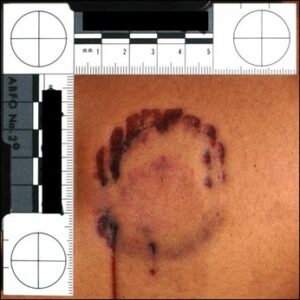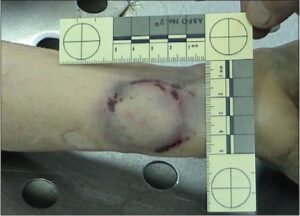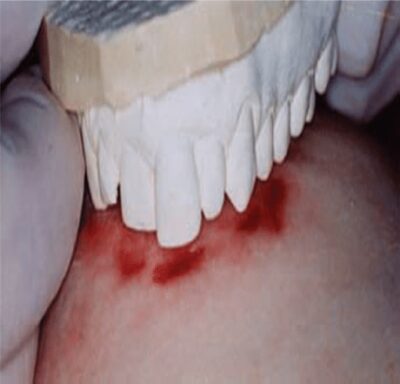As a society, we rely on our justice system to provide fair and accurate verdicts in criminal cases. However, the use of bite mark analysis as evidence in these cases has recently come under scrutiny. Despite its use for over a century, doubts have arisen about the accuracy and reliability of this technique. The lack of scientific evidence to support it, coupled with potential distortions, lack of consensus among experts, and the possibility of bias, all point to the conclusion that bite mark analysis should not be used as a sole basis for a conviction. In this paper, we will examine the problems with bite mark analysis and argue that it is not a reliable form of evidence.
History and Background
Evidence of bite marks has been used as evidence in criminal cases since the late nineteenth century. The first documented case where bite mark analysis was used was 1954 case Doyle v. State of Texas. This involved an assailant who left his bite mark in a lump of cheese at the scene. As a result, bite mark evidence has been used to identify suspects in criminal cases and has been accepted by courts as evidence. A report published by the National Academy of Sciences (NAS) in the 1990s stated that “bite mark analysis is not admissible in court” because it has not been scientifically validated.1 In recent years, numerous studies and reports have demonstrated the inaccuracy of bite mark analysis in criminal cases. A recent case is the case of Ray Krone. Ray Krone, 35, was arrested in 1991 for the murder of a Phoenix bartender (Kim Ancona). As a result, he was sentenced to death as well as 21 years of imprisonment. The jagged teeth of Krone have earned him the nickname “snaggle-tooth killer” due to the impression they leave on a Styrofoam cup.2 Despite the fact that the victim had been fatally stabbed, no physical evidence had been left behind. Fingerprints were not found; the blood at the scene matched the victim’s type; and the saliva on her body was from someone with the most common blood type. DNA testing was not performed, and no semen was present. As a consequence, the bite marks (found on the breast and neck of the murder victim) were the sole evidence used by the prosecution to convict him.
Despite winning a retrial in 1996, Krone was convicted again based largely on the testimony of the state’s “expert” in the bite-mark case.2 A retrial resulted in the death sentence being reduced to life imprisonment. Ultimately, Krone was released in 2002 after DNA testing indicated that he was not responsible for the crime. It was discovered that the victim’s saliva and blood matched those of a convicted rapist.2 Despite the fact that bite marks can be helpful in some circumstances, they should never be used as the sole evidence to convict or acquit a defendant.

Despite the fact that bite marks can be helpful in some circumstances, they should never be used as the sole evidence to convict or acquit a defendant. Analyzing bite marks on a victim’s body or on other objects, such as food or clothing, is part of bite mark analysis. Several methods are used by forensic professionals, including photographic documentation, measurement and comparison of bite marks, and the study of tooth impressions. Methods such as these are used to analyze these marks. The forensic science technique of analyzing bite marks has a long and illustrious history.5 As a primary source of evidence for law enforcement agencies and forensic professionals over the years, bite mark analysis is increasingly common in criminal investigations. It has been questioned in recent years whether this technique is scientifically valid, as we will examine in the following sections.6
When a bite mark is examined and compared to the teeth of the suspect, a bite mark analysis is performed. The investigation is based on the theory that every individual’s teeth are distinct and can be correlated to a particular bite mark.7 Several problems arise from this premise. Despite the fact that teeth are distinctive, the way in which they leave bite marks can be affected by several factors. The angle and power of the bite, as well as the surface on which it is executed, are among these elements. Bits of evidence indicating an individual’s identity can often be used to identify a suspect during a criminal investigation. This is particularly useful in sexual assault or homicide. The accuracy of bite mark analysis has been questioned due to the possibility of distortions in the pattern.8 It is also highly subjective in nature.

Pros of Bitemark Analysis
Analyzing bite marks supplies a link between a suspect and a crime scene. As an example, Ted Bundy was convicted of murder in 1978 as a result of a bite mark, he left on a victim’s buttock. The analysis of bite marks is considered valid evidence by many criminal law experts. Souviron and Haller suggest that bite mark analysis can help determine the type of bite and the perpetrator’s identity. Forensic dentists, for instance, can compare the characteristics of a person’s teeth to determine whether they are the same. Furthermore, bite marks can be used to identify a suspect by providing information such as age, gender, and race.
The analysis of bite marks provides investigators with the opportunity to connect multiple pieces of evidence and come up with a comprehensive picture of the crime. A bite mark analysis can, for instance, provide additional evidence to support a witness’ testimony or physical evidence. This can help investigators paint a more accurate picture of themselves and help corroborate other pieces of evidence.7 Similarly, a bite mark analysis can serve as additional evidence to support or disprove a witness or suspect’s testimony.
Last but not least, bite marks can be used to narrow the list of suspects. Using the characteristics of a bite mark, investigators can identify possible suspects, and then utilize other evidence to determine if those suspects are likely to have committed the crime.7 This can be a valuable tool in an investigation, as it can help investigators quickly and accurately identify a perpetrator.
Despite the many benefits of bite mark analysis, this evidence is not infallible. It is vital to use other forms of evidence, such as DNA testing, to corroborate any conclusions made from a bite mark analysis.11 Furthermore, it is crucial to be aware of potential errors and biases when analyzing bite marks. Even with these limitations, bite mark evidence can be used to support an investigation.
Cons of Bitemark Analysis
There is a lack of scientific evidence to support the reliability of bite mark analysis, despite its wide use as a forensic tool for identifying perpetrators of crimes. A report by the National Academy of Sciences concluded that bite mark comparison accuracy was not reliable (Report: Bite mark Analysis Debunked as Pseudoscience). As a result, this technique can be misleading and result in wrongful convictions.
Several factors contribute to bite mark analysis unreliability. One of these is that bite marks are highly susceptible to distortion. This is due to factors such as the skin’s elasticity, individual differences in the characteristics of the bite, and the physical trauma that occurs when the bite is inflicted.12 This makes it challenging to match the bite mark to a particular ailment.
The subjective interpretation of bite marks also renders bite mark analysis unreliable. This means the analyst can be influenced by personal bias and preconceived assumptions. This was demonstrated in a study that compared the results of two analysts and found that “the results of the two analysts often differed dramatically“.7 Moreover, there is no established method for training analysts who examine bite marks. As a result, there is no way to ensure that analysts use the same criteria when examining bite marks. Thus, comparing the results of different analysts and determining which is more accurate is difficult.1 Several cases have been reported in which bite mark analysis has been used to incorrectly identify a suspect. There was a case in Texas in which a man was wrongfully convicted of murder based on unreliable bite mark evidence.8 Innocent individuals may be convicted of crimes for which they did not commit due to the use of bite mark analysis.
The unreliability of bite mark analysis is further demonstrated by its unreliability as a forensic science tool. This is because the technique is not based on scientific principles and is often viewed as pseudoscience.5 This has led to it being discredited by many prominent experts in the field, including the Innocence Project. The Innocence Project states that “bite mark evidence has been used to identify suspects in numerous cases wrongly”.11 In terms of reliability, bite mark analysis is fraught with difficulties. There are many subjective aspects to this type of forensic science, it is susceptible to distortion, and it is not universally accepted as an exceptionally reliable method. Therefore, it should not be used in criminal proceedings as a primary form of evidence.
Validity and Reliability of Bitemark Analysis
Historically, bite mark analysis has been used as an important piece of evidence in some court cases. However, many experts have questioned its use due to its lack of scientific validity and reliability.7 It has been used to identify suspects in criminal cases or human remains in disaster cases.5 According to the Innocence Project, bite mark evidence is a pseudoscience intended to wrongly convict innocent people.8
The reliability of bite mark analysis has not been proven scientifically. Several studies have shown that bite marks are ineffective in identifying the biter because they can easily be distorted.21 Moreover, experts should agree on the appropriate methods for analyzing bite marks, since different experts may interpret bite marks differently.1 It is also important to note that the accuracy of bite mark analysis can be affected by a number of factors, including the age of the bite marks, the physical properties of the skin, and the dentition of the individual.6
The use of bite marks has also been found in cases where the evidence is weak or inconclusive. This raises questions about the reliability of the evidence, as it is possible that bite mark evidence is used to bolster a weak case.11 Furthermore, bite mark analysis can be subject to bias, as examiners may have preconceived notions about the biter’s identity.7
A number of innocent people have been wrongfully convicted as a result of bite mark analysis. It has been documented by the Innocence Project that bite mark analysis has resulted in unfair arrests and convictions due to DNA testing.8 This illustrates the unreliability of bite mark analysis as a forensic tool. The analysis of bite marks is not the most reliable method of identification. Even though there is no scientific evidence that suggests it is an effective identification method, this method has been used to wrongfully convict innocent individuals. There is a tendency for this type of evidence to be biased and to be used to bolster weak cases. Thus, bite mark analysis should not be considered a sole basis for conviction.
Future of Bitemark Analysis
Bite mark analysis is currently experiencing a credibility crisis. The reliability and accuracy of bite mark analysis have been questioned in peer-reviewed studies and DNA evidence. In light of this, many have called for a change in the way bite mark analysis is used in criminal proceedings. The Innocence Project calls for “eliminating bite mark evidence from criminal trials“.11 In addition, the National Commission on Forensic Science has recommended that bite mark analysis should no longer be used as a form of identification.5
A number of experts have called for a shift away from bite mark analysis as an identification method and toward a more scientific approach. It involves the analysis of patterns in bite marks, such as the shape and size of the teeth, rather than identifying the perpetrator. This is supported by recent research, which finds that even when bite marks are distorted, patterns can still be discerned.29 Furthermore, more accurate and reliable data may be obtained by using advanced imaging techniques, such as 3D scanning and digital photography. Before bit mark analysis can be considered a reliable forensic science, there is much more work to be done. It must be subject to rigorous scientific standards and protocols in criminal cases. Its accuracy and reliability must be regularly tested and evaluated. Until this is achieved, bite mark analysis should only be used to supplement more reliable forms of evidence, such as DNA analysis.

Conclusion
Bite mark analysis is a forensic technique used to identify suspects in criminal investigations. The reliability of this method has been questioned due to its susceptibility to distortion, lack of consensus among experts, and potential for bias. Additionally, bite mark analysis has been used unfairly against innocent individuals. It is not reliable to use bite mark analysis alone for a conviction. Other forms of evidence should corroborate any conclusions made from a bite mark examination.
- Jones, J. (2012, April 18). Forensic Tools: What is Reliable and What is Not-So-Scientific. FRONTLINE.(para: 16-18) https://www.pbs.org/wgbh/frontline/article/forensic-tools-whats-reliable-and-whats-not-so-scientific/. ↵
- Says, K. B. (2007, January 31). Cases Where DNA Revealed that Bite Mark Analysis Led to Wrongful Arrests and Convictions. Innocence Project.(para 9) https://innocenceproject.org/cases-where-dna-revealed-that-bite-mark-analysis-led-to-wrongful-arrests-and-convictions/. ↵
- Says, K. B. (2007, January 31). Cases Where DNA Revealed that Bite Mark Analysis Led to Wrongful Arrests and Convictions. Innocence Project.(para 9) https://innocenceproject.org/cases-where-dna-revealed-that-bite-mark-analysis-led-to-wrongful-arrests-and-convictions/. ↵
- Says, K. B. (2007, January 31). Cases Where DNA Revealed that Bite Mark Analysis Led to Wrongful Arrests and Convictions. Innocence Project.(para 9) https://innocenceproject.org/cases-where-dna-revealed-that-bite-mark-analysis-led-to-wrongful-arrests-and-convictions/. ↵
- Crime Museum, LLC. (2021, June 24). Bite Marks – Crime Museum. Crime Museum. https://www.crimemuseum.org/crime-library/forensic-investigation/bite-marks/. ↵
- Samuel D. Hodge Jr. and Robert E. Rains, Bite Mark Identification – A Reliable Forensic Tool or Junk Science, 88 Pa. B. Ass’n Q. 109 (2017). ↵
- Souviron, R., & Haller, L. A. (2017). Bite mark evidence: bite mark analysis is not the same as bite mark comparison or matching, or identification. Journal of Law and the Biosciences, 4(3), 617–622. https://doi.org/10.1093/jlb/lsx026. ↵
- Maule, A. (2018b, June 27). Cases Where DNA Revealed that Bite Mark Analysis Led Wrongful Arrests and Convictions – Innocence Project. Innocence Project. https://innocenceproject.org/cases-where-dna-revealed-that-bite-mark-analysis-led-to-wrongful-arrests-and-convictions/. ↵
- Souviron, R., & Haller, L. A. (2017). Bite mark evidence: bite mark analysis is not the same as bite mark comparison or matching, or identification. Journal of Law and the Biosciences, 4(3), 617–622. https://doi.org/10.1093/jlb/lsx026. ↵
- Souviron, R., & Haller, L. A. (2017). Bite mark evidence: bite mark analysis is not the same as bite mark comparison or matching, or identification. Journal of Law and the Biosciences, 4(3), 617–622. https://doi.org/10.1093/jlb/lsx026. ↵
- Freeman, A. (2020, May 1). Bite Mark Evidence: What You Should Know About This Debunked Science. Innocence Project. https://innocenceproject.org/what-is-bite-mark-evidence-forensic-science/. ↵
- Dama, N., Forgie, A., Mânica, S., & Revie, G. (2020). Exploring the degrees of distortion in simulated human bite marks. International journal of legal medicine, p.1048 pp.4. https://doi.org/10.1007/s00414-019-02163-5. ↵
- Souviron, R., & Haller, L. A. (2017). Bite mark evidence: bite mark analysis is not the same as bite mark comparison or matching, or identification. Journal of Law and the Biosciences, 4(3), 617–622. https://doi.org/10.1093/jlb/lsx026. ↵
- Jones, J. (2012, April 18). Forensic Tools: What is Reliable and What is Not-So-Scientific. FRONTLINE.(para: 16-18) https://www.pbs.org/wgbh/frontline/article/forensic-tools-whats-reliable-and-whats-not-so-scientific/. ↵
- Maule, A. (2018b, June 27). Cases Where DNA Revealed that Bite Mark Analysis Led Wrongful Arrests and Convictions – Innocence Project. Innocence Project. https://innocenceproject.org/cases-where-dna-revealed-that-bite-mark-analysis-led-to-wrongful-arrests-and-convictions/. ↵
- Crime Museum, LLC. (2021, June 24). Bite Marks – Crime Museum. Crime Museum. https://www.crimemuseum.org/crime-library/forensic-investigation/bite-marks/. ↵
- Freeman, A. (2020, May 1). Bite Mark Evidence: What You Should Know About This Debunked Science. Innocence Project. https://innocenceproject.org/what-is-bite-mark-evidence-forensic-science/. ↵
- Souviron, R., & Haller, L. A. (2017). Bite mark evidence: bite mark analysis is not the same as bite mark comparison or matching, or identification. Journal of Law and the Biosciences, 4(3), 617–622. https://doi.org/10.1093/jlb/lsx026. ↵
- Crime Museum, LLC. (2021, June 24). Bite Marks – Crime Museum. Crime Museum. https://www.crimemuseum.org/crime-library/forensic-investigation/bite-marks/. ↵
- Maule, A. (2018b, June 27). Cases Where DNA Revealed that Bite Mark Analysis Led Wrongful Arrests and Convictions – Innocence Project. Innocence Project. https://innocenceproject.org/cases-where-dna-revealed-that-bite-mark-analysis-led-to-wrongful-arrests-and-convictions/. ↵
- Dama, N., Forgie, A., Mânica, S., & Revie, G. (2020). Exploring the degrees of distortion in simulated human bite marks. International journal of legal medicine, p.1048 pp.6. https://doi.org/10.1007/s00414-019-02163-5. ↵
- Jones, J. (2012, April 18). Forensic Tools: What is Reliable and What is Not-So-Scientific. FRONTLINE.(para: 16-18) https://www.pbs.org/wgbh/frontline/article/forensic-tools-whats-reliable-and-whats-not-so-scientific/. ↵
- Samuel D. Hodge Jr. and Robert E. Rains, Bite Mark Identification – A Reliable Forensic Tool or Junk Science, 88 Pa. B. Ass’n Q. 109 (2017). ↵
- Freeman, A. (2020, May 1). Bite Mark Evidence: What You Should Know About This Debunked Science. Innocence Project. https://innocenceproject.org/what-is-bite-mark-evidence-forensic-science/. ↵
- Souviron, R., & Haller, L. A. (2017). Bite mark evidence: bite mark analysis is not the same as bite mark comparison or matching, or identification. Journal of Law and the Biosciences, 4(3), 617–622. https://doi.org/10.1093/jlb/lsx026. ↵
- Maule, A. (2018b, June 27). Cases Where DNA Revealed that Bite Mark Analysis Led Wrongful Arrests and Convictions – Innocence Project. Innocence Project. https://innocenceproject.org/cases-where-dna-revealed-that-bite-mark-analysis-led-to-wrongful-arrests-and-convictions/. ↵
- Freeman, A. (2020, May 1). Bite Mark Evidence: What You Should Know About This Debunked Science. Innocence Project. https://innocenceproject.org/what-is-bite-mark-evidence-forensic-science/. ↵
- Crime Museum, LLC. (2021, June 24). Bite Marks – Crime Museum. Crime Museum. https://www.crimemuseum.org/crime-library/forensic-investigation/bite-marks/. ↵
- Dama, N., Forgie, A., Mânica, S., & Revie, G. (2020). Exploring the degrees of distortion in simulated human bite marks. International journal of legal medicine,1043 para.3. https://doi.org/10.1007/s00414-019-02163-5. ↵




19 comments
A'marie Pollard
I am fascinated by this article. I think it’s interesting how criminal justice is always evolving. Being able to determine a victims killer age, gender and race based off teeth markings is remarkable. I wonder how this newfound technique would have changed the criminal justice community during a previous time and era. I really enjoyed your article thank you for taking the time to talk about such an important and interesting topic.
Gaitan Martinez
Very interesting article. Bite marks are very unique, so I can see why forensic analysts could use them. Also, I can imagine many people biting an attacker, so it could be very common. So this method can really be useful to determine attackers. Forensic science has really progressed, and sooner or later, it’s gonna be impossible to get away with any crime.
Christian Lopez
For someone that is interested in forensic science I love to see articles like this that highlight the lesser know types of ID evidence. Bitting technology is such an underrated DNA/Identification science in the field of forensics. Large crimes such as Ted Bundy have been solved and charged over biting patterns.
Gabriella Parra
Kendra! Congratulations on your nomination! This is a very interesting topic. I’ve never really thought of this kind of forensic evidence. Oftentimes we focus on getting DNA from hair or body fluids, finding fingerprints, and methods like that. I can see how bite marks can be useful in violent crimes. It is interesting, though, that this kind of evidence is fairly subjective. No verdict should probably rest on bite mark evidence alone.
Abbey Stiffler
The fact that bite marks can sometimes be ineffectual in cases interests me greatly because I had no idea how much influence they can have on case decisions. I believe it’s challenging to get a strong bite with distinct edges. Bight marks shouldn’t be the single or the primary source of evidence. Bite-marks are often used as the only proof against a person who has been found guilty because there doesn’t seem to be enough other evidence.
Isabel Soto
Congratulation on getting your article published. I never realized just how bitemarks can affect the decisions of a case, so learning how they can be ineffective in some matters is very interesting to me. I always wondered how much a bite mark truly helps with a forensic investigation, and I’m glad you gave your own opinion after laying out the pros and cons.
Gabriella Galdeano
Congratulations on your nomination! I found this article very interesting because dentistry is involved. I like how you do not condemn the use of bite mark analysis and make it clear that it can be used as supportive evidence to convict someone. As you said, this type of analysis would need to be updated to ensure its reliability before using as the sole evidence for a conviction.
Muhammad Hammad Zafar
Awesome, one of the amazing forensic techniques for criminal investigations although there is always probability either by the investigator or trainer. As said that it is not always right and many innocent people have been the victim of it.
Melanie Fraire
I’ve always found the use of bite marks as forensic evidence to be very interesting considering that they are solely using the markings of the teeth and not any type of DNA evidence. It was also interesting to read about the history of the use of teeth marks as evidence. Overall, this was a very informative article.
Mark Gallegos
This is a very interesting article! You did a great job of putting so much detail and thought in this informative article. I always wondered how much a bite mark truly helps with a forensic investigation, and I’m glad you gave your own opinion after laying out the pros and cons.